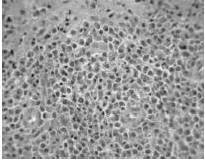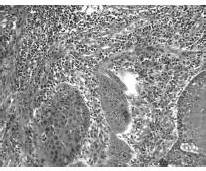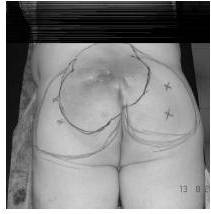Discussion
Simultaneous occurrence of EMP and SCC is rare and has been only occasionally reported at lung, tonsil and breast level [Dasmahapatra, 1986; Junquera, 2009; Cao, 2009]. In addition, Jayagopal et al. described a case of SCC of the skin where EMP was evidenced at the margin of the specimen. These authors supposed that EMP might have reflected a malignant transformation of a host-immune reaction to a previous SCC [Jayagopal, 2004].
In our patient, SCC was identified on samples obtained by a large excision of a skin tract previously treated with radiotherapy for EMP. The occurrence of SCC on irradiated skin has been described as a possible mutagen effect of radiotherapy [Van Vloten, 1987]. In our case, however, the time from treatment to the identification of SCC was probably too short to explain this linkage.
The hypothesis that the two neoplasms were synchronous is also weak, since SCC and EMP are both rare, as single disease, at sacro-coccygeal region; on the other hand, no simultaneous evidence of both disease was shown in our patient. Even if the hypothesis that EMP is due to a malignant transformation of a preavius reactive plasmacellular infiltration is the most acceptable, we favour the alternative possibility that EMP by itself, in combination with post-radiation persistent chronic inflammatory reaction, could have played a (cytokine-mediated?) local “oncologic promoter” role, inducing the rapid development of SCC.
References
Cao, S., Kang, H. G., Liu, Y. X. & Ren, X. B. (2009). “Synchronous Infiltrating Ductal Carcinoma and Primary Extramedullary Plasmacytoma of the Breast,” World J Surg Oncol 2009; 7: 43.
Publisher – Google Scholar
Chao, M. W., Gibbs, P., Wirth, A., et al. (2005). “Radiotherapy in the Management of Solitary Extramedullary Plasmacytoma,” Intern Med J 2005; 35: 211-215.
Publisher – Google Scholar
Dasmahapatra, H. K., Candlish, W. & Davidson, K. G. (1986). “Combined Plasmacytoma and Squamous Cell Carcinoma,” J Thorac Cardiovasc Surg 1986; 34: 403-405.
Publisher – Google Scholar
Dimopoulos, M. A. & Hamilos, G. (2002). “Solitary Bone Plasmocytoma and Extramedullary Plasmocytoma,” Curr Treat Options Oncol 2002; 3: 255-259.
Publisher – Google Scholar
Jayagopal, S., Berry, M. G., Ross, G., et al. (2004). “A Case of Squamous Cell Carcinoma Associated with Plasmacytoma,” Br J Plast Surg 2004; 57: 172-173.
Publisher – Google Scholar
Junquera, L., Gallego, L., Torre, A., et al. (2009). “Synchronous Oral Squamous Cell Carcinoma and Extramedullary Plasmacytoma af the Tonsil,” Oral Surg Oral Pathol Oral Radiol Endod 2009; 108: 413-416.
Publisher – Google Scholar
Soutar, R., Lucraft, H., Jackson, G., Reece, A., Bird, J., Low, E. & Samson, D. Guidelines Working Group of the UK Myeloma Forum (UKMF). (2004). “Guidelines on the Diagnosis and Management of Solitary Plasmacytoma of Bone and Solitary Extramedullary Plasmacytoma,” Br J Haematol 2004; 124: 717-726.
Publisher – Google Scholar
Van Vloten, W. A., Hermans, J. & Van Daal, W. A. J. (1987). “Radiation-Induced Skin Cancer and Radiodermatitis of the Head and Neck,” Cancer 1987; 59: 411-414.
Publisher – Google Scholar
Weber, D. M. (2005). “Solitary Bone and Extramedullary Plasmacytoma,” Hematology — American Society of Hematology. Educational Program Book 2005: 373-376.
Publisher – Google Scholar






